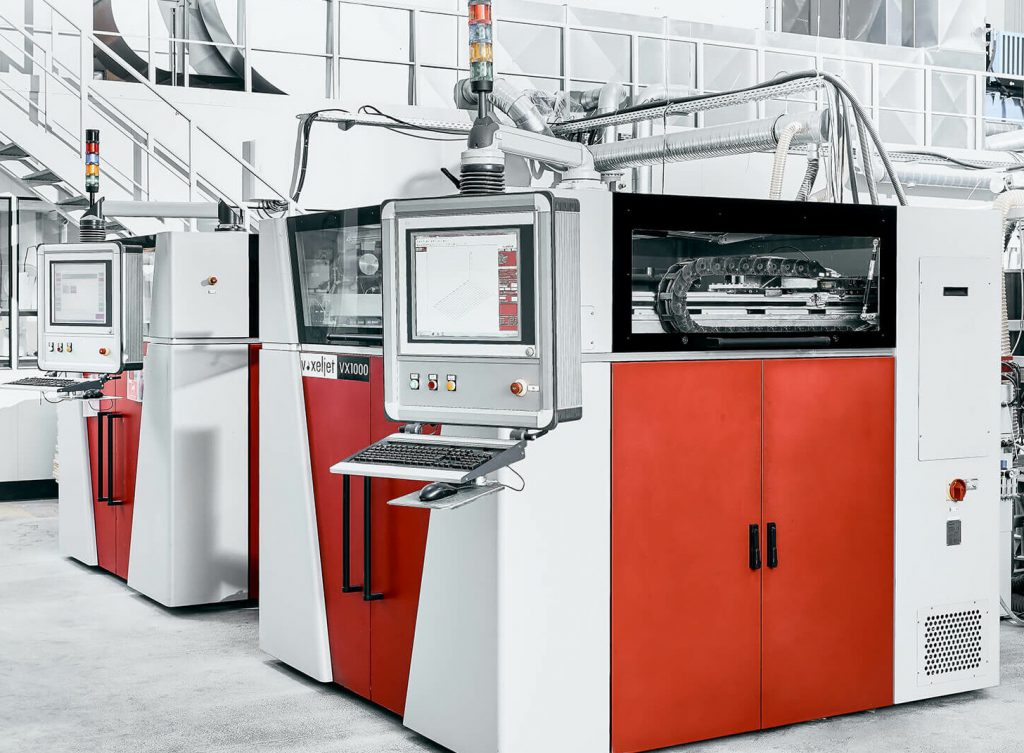Binder jet 3D printer manufacturer voxeljet (VJET) saw its revenue rise by 22.9% in Q4 2021, according to its recently-published financials.
Over the course of Q4 2021, the firm brought in €10.9 million, €2 million more than the €8.9 million it reported in Q4 2020 and a €1.3 million increase on the €9.6 million it amassed during the pre-COVID Q4 2019. On voxeljet’s earnings call, its CEO Dr. Ingo Ederer explained how it had sold a “higher number of larger scale printers” in the quarter, thus allowing it to “generate higher revenues and gross margins.”
“We ended 2021 with a number of notable achievements that underscore the growing demand across our product portfolio, increasing market dynamics and greater recognition of voxeljet’s leading 3D printing technology for industrial applications,” said Ederer. “Overall, the fourth quarter of 2021 was a record sales quarter for our company and we are pleased that this momentum has continued in the first months of the new year.”

voxeljet’s Q4 2021 financials
Although voxeljet markets on-demand production services in Germany, the US, UK, China and India, it derives the majority of its revenue from the sale of its High-Speed Sintering (HSS) and binder jet 3D printers. With this in mind, the firm reports its income across two main segments: Services and Systems, with the latter also including any revenue generated by its part or maintenance-related sales.
During Q4 2021, voxeljet’s Systems not only remained its highest earning division, but became its fastest growing, after its 3D printer sales had fallen in Q3 2021. This return to form, however, was not necessarily down to the number of units the company managed to sell, as it sold seven new, as well as two used and refurbished machines in Q4 2021, compared to the six new and two used delivered in Q4 2020.
In fact, voxeljet says it actually “sold more larger-scale platforms as opposed to smaller platforms,” hence its revenue rise is as much the result of product mix as its number of units sold. Elsewhere, the firm has revealed that the division’s consumable, spare part and maintenance revenue also increased over Q4 2021, reflecting a recovery from the “economic slowdown” caused by COVID-19.
In line with this shift in its product mix, voxeljet’s gross profit jumped 19.5% from €3 million to €3.6 million in Q4 2021, although this figure was offset by a non-recurring charge of €7 million. Without the charge, said to be related to its slow-moving inventory, the company says its gross profit margin would have been 39%, well above its initial guidance of 32.5%.
Compared to its Systems segment, voxeljet’s Services grew more slowly between Q4 2020 and Q4 2021, from €2.2 million to €2.4 million. Where the division did see growth over this period, it was primarily driven by its Germany and China-based operations, with the former understood to have delivered strong margin results, and the revenue generated by its US business to have been flat against Q4 2020.
| voxeljet Financials (€) | Q4 2020 | Q4 2021 | Difference (%) | Q4 2019 | Q4 2021 | Difference (%) |
| Revenue | 8.9m | 10.9m | +22.9 | 9.6m | 10.9m | +14 |
| Cost of Sales | 5.9m | 7.3m | +24.6 | 6.7m | 7.3m | +9.7 |
| Gross Profit | 3m | 3.6m | +19.5 | 2.9m | 3.6m | +25.9 |
| Net Profit/Loss | -3.7m | +1m | +370 | -3.6m | +1m | +360 |
Plotting future growth at voxeljet
During voxeljet’s earnings call, Ederer suggested that advances in its technologies could soon allow it to gain a larger share of the lucrative, high-end polymer 3D printing market. Compared to the Multi Jet Fusion (MJF) systems developed by HP, the firm’s CEO even went so far as to say that its printers offer users greater cost and build efficiency, potentially giving it an advantage moving forwards.
“Our process is cheaper in operation for our customers and results in lower cost per part,” Ederer said on the call. “Powders from our machines use less heat than that of our competitors, which means that it degrades more slowly and should be easier to recycle. The improved temperature management from the IR lamp setup also allows us to process large build areas without major problems from temperature-induced warping.”
Additionally, Ederer highlighted how voxeljet’s VJET X machine will be key to its future success in addressing applications in which direct metal printing is not an option. Through combining 3D printing and conventional production, Ederer boasted that the system is capable of producing “several hundred thousand parts per year” with a single cell, lending it strong industrial manufacturing credentials.
Having upgraded the printer’s engine and binder composition, as well as the way its parts are handled and cured, the Ederer added that it had improved the unit’s pace and level of automation, culminating in its decision to begin supplying parts for pre-series production in early-2021, and its first two machines gaining ‘final acceptance’ in December.
“I expect our position to grow significantly with VJET X,” explained Ederer. “I believe so because we have been working with leading industrial OEMs, basically since our foundation, we sold our first 3D printer to BMW and Daimler 20 years ago. In addition, our technology has evolved significantly over the last years in terms of speed, accuracy and the degree of automation of the whole process chain.”
“I would estimate that with our current portfolio of 3D printers, our share in sales to manufacturing is already higher than any of our competitors.”

‘Hedging against risk’ in FY 2022
As of December 31, 2021, voxeljet had an order backlog of €3.9 million, with at least one of these orders known to include a unit sold to an existing car manufacturing client. While this figure is lower than the €6.8 million backlog the company had in Q4 2020, Ederer suggested on its earnings call, that it has targeted an “even distribution across its three regions,” to “hedge against risk from local events.”
With regards to such global disruptions, voxeljet’s CEO also took the opportunity to criticize Russia’s invasion of Ukraine on the call, as an “unprovoked reckless attack.” To take a stance against the country’s actions, he said his firm had stopped servicing users in Russia and Belarus “weeks ago” and wouldn’t be resuming its activities there for the “foreseeable future.”
That being said, voxeljet’s guidance of €25 million to €30 million for FY 2022 doesn’t seem to indicate that it’s anticipating the war on Ukraine causing disruption to its business, as at the top end, it could achieve growth of up to 20.8%. Likewise, the company is in a strong cash position to finance its activities over the year ahead, with €22.7 million at the end of FY 2021, and further funds available via the EIB.
To stay up to date with the latest 3D printing news, don’t forget to subscribe to the 3D Printing Industry newsletter or follow us on Twitter or liking our page on Facebook.
For a deeper dive into additive manufacturing, you can now subscribe to our Youtube channel, featuring discussion, debriefs, and shots of 3D printing in-action.
Are you looking for a job in the additive manufacturing industry? Visit 3D Printing Jobs for a selection of roles in the industry.
Featured image shows a sign at voxeljet HQ. Photo via voxeljet.


